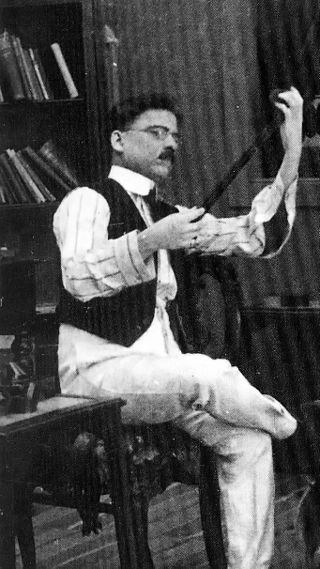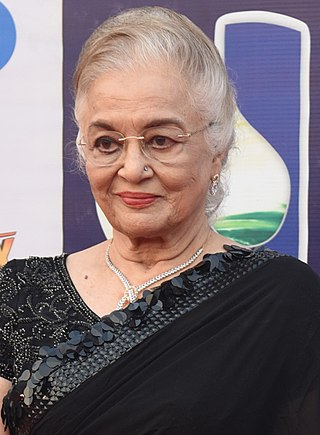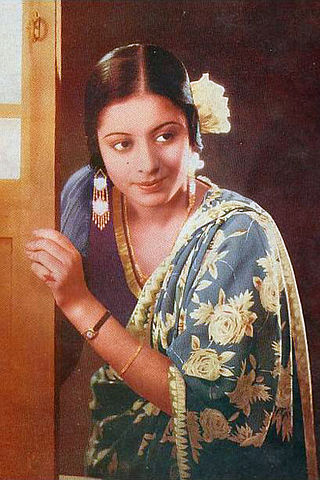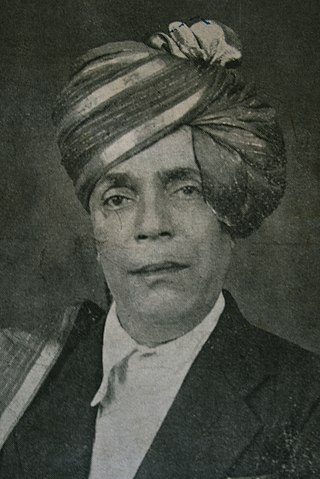
Devika Rani Chaudhuri, usually known as Devika Rani, was an Indian actress who worked in Hindi films. She was the first recipient of the Dadasaheb Phalke Award and was awarded the Padma Shri. Widely acknowledged as the First Lady of Indian cinema, Devika Rani is regarded as one of the greatest actresses. One of the highest-paid actress of the 1930s early 1940s, she appeared in Box Office India's "Top Actresses" list in 1940 and 1941.

The Dadasaheb Phalke Award is India's highest award in the field of cinema. It is presented annually at the National Film Awards ceremony by the Directorate of Film Festivals, an organisation set up by the Ministry of Information and Broadcasting. The recipient is honoured for their "great and outstanding contribution to the growth and development of Indian cinema" and is selected by a committee consisting of eminent personalities from the Indian film industry. The award comprises a Swarna Kamal medallion, a shawl, and a cash prize of ₹1,000,000 (US$12,000).

Baldev Raj Chopra was a prolific Indian director and producer noted for pioneering the Hindi film industry and television series. He's known for directing notable films, such as Afsana, Ek Hi Raasta, Naya Daur, Sadhna, Kanoon, Gumrah, Hamraaz, Dhund, Pati Patni Aur Woh, Insaf Ka Tarazu and Nikaah. He also produced hit films, including Dhool Ka Phool, Waqt, Ittefaq, Aadmi Aur Insaan, Chhoti Si Baat, The Burning Train, Aaj Ki Awaaz, Baghban and the TV series, Mahabharat. He was awarded Dadasaheb Phalke Award, India's highest award in cinema, for the year 1998, and Padma Bhushan, India's third highest civilian award, in 2001.

Dhundiraj Govind Phalke, popularly known as Dadasaheb Phalke, was an Indian producer-director-screenwriter, known as "the Father of Indian cinema".

Asha Parekh is an Indian actress, film director, and producer who worked in Hindi films. Regarded as one of Hindi cinema's finest actresses, Parekh has worked in more than 85 films, in a career spanning over four decades. She has received several accolades including two Filmfare Awards. In 1992, she was honoured with the Padma Shri by the Government of India for her contribution to the field of cinema and was honoured with Dadasaheb Phalke Award in 2020.

Durga Khote was an Indian actress, beginning as one of the foremost leading ladies of her time. She remained active in Hindi and Marathi cinema, as well as theatre, for over 50 years, starring in around 200 films and numerous theatre productions.

Ruby Myers, better known by her stage name Sulochana, was an Indian silent film actress of Jewish ancestry, from the community of Baghdadi Jews in India.

Khan Bahadur Ardeshir Irani was a writer, director, producer, actor, film distributor, film showman and cinematographer in the silent and sound eras of early Indian cinema. He is considered one of the greatest personalities in recent Indian Cinema. He was the director of India's first sound film Alam Ara. He was the producer of India's first colour film Kisan Kanya. He was renowned for making films in Hindi, Telugu, English, German, Indonesian, Persian, Urdu and Tamil. He was a successful entrepreneur who owned film theatres, a gramophone agency, and a car agency.

Kanan Devi was an Indian actress and singer. She was among the early singing stars of Indian cinema, and is credited popularly as the first star of Bengali cinema. Her singing style, usually in rapid tempo, was used instrumentally in some of the biggest hits of New Theatres, Kolkata.
Madan Theatre Company, also known as Madan Theatres Limited or Madan Theatres in short, was a film production company founded by Jamshedji Framji & his partner Kanhaiyalal Kaushik, one of the pioneers of Indian Cinema.

Paidi Jairaj was an Indian actor, director and producer known for his works majorly in Hindi; few Marathi, Gujarati, Telugu language films, and Telugu theatre. During the talkie period, from 1931 onwards, he started with Shikari in Urdu and English languages. Subsequently, he became one of the leading actors for about two decades, along with V. Shantaram, Ashok Kumar, Prithviraj Kapoor, Motilal etc. He starred in about 170 feature films in a variety of roles. He directed a few films such as Mohar, Mala (1943), Pratima, Rajghar and Saagar (1951), which he produced. In 1980, he was awarded with the Dadasaheb Phalke Award, the highest award for films in India, for his contributions to Indian cinema.

Satyawadi Raja Harishchandra is a 1917 silent black and white Indian film based on Hindu mythology, directed by Rustomji Dhotiwala. It was produced by J. F. Madan's Elphinstone Bioscope. Credited as the first remake in Indian cinema, the film is a remake of the first Indian feature film, Raja Harishchandra (1913) and was also inspired by an Urdu language drama, Harishchandra. The film is based on the mythological story of a Hindu King Harishchandra, the 36th king of the Solar Dynasty, who donated his entire kingdom and sold himself and his family to keep the promise given to the sage Vishvamitra in the dream. It is also the first feature film made in Calcutta. The intertitles used in the film were in Bengali language as the film was a silent film. The film was released on 24 March 1917 at New Tent Maidan, Calcutta.

Gulzar is an Indian Urdu poet, lyricist, author, screenwriter, and film director known for his works in Hindi cinema. He is regarded as one of greatest Urdu poets of this era. He started his career with music director S.D. Burman as a lyricist in the 1963 film Bandini and worked with many music directors including R. D. Burman, Salil Chowdhury, Vishal Bhardwaj and A. R. Rahman. Gulzar also writes poetry, dialogues and scripts. He directed films such as Aandhi and Mausam during the 1970s and the TV series Mirza Ghalib in the 1980s. He also directed Kirdaar in 1993.

Vishwanath Jadhav was an Indian classical khyal singer and a disciple of Abdul Karim Khan, the founder of Kirana gharana.
Durgabai Kamat was a Indian Marathi actress, who was the first actress in Indian cinema. She is known as The First Female Actress in Indian Cinema when she acted in film Mohini Bhasmasur in 1913 at that time when it was not considered an appropriate profession for girls from respectable families.
Mohini Bhasmasur is a 1913 Indian mythological film directed by Dadasaheb Phalke and starring Kamlabai Gokhale and Durgabai Kamat. It is India's and Phalke's second full-length feature film. Mohini Bhasmasur is the first Indian film to have a female actor. In Raja Harischandra, India's and Phalke's first film, the role of the female was played by Anna Salunke, a male.














